Posted under Italy

We had barely just arrived in Florence and were already off to the Galleria dell’Accademia (Do not pass “Go”; Do not collect $200) to feast our eyes on David’s aesthetically pleasing, classically small penis. Michelangelo’s David is the world’s most famous sculpture and, as we stood in line for the gallery – full of many priceless works of art – the David was all we could talk about. Once inside, I half-expected a Louvre-like experience where everyone makes a mad dash for the Mona Lisa, passing long halls of brilliant masterpieces at a speedwalker’s pace, but I was pleasantly surprised to discover a reasonable level of restraint among my fellow art lovers. This collective civilized behavior resulted in a relaxed ambience which allowed everyone to enjoy the art-filled rooms leading to the David.
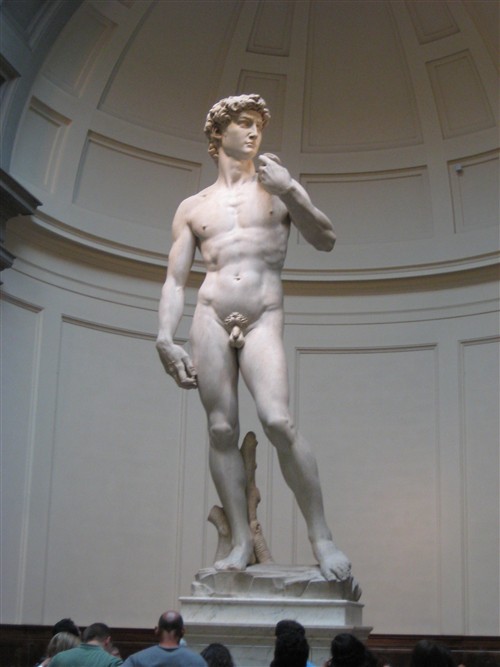 David, standing 5.16 meters tall in pearly white marble, bathed in perfect soft light, muscles tensed, with a mane like Adonis, is a vision of jaw-dropping perfection of the male form. I had seen countless photos of him and still he was more beautiful than I imagined. He is so striking that you cannot take your eyes off him; you can only stare at him in total awe. There were rooms of oil paintings surrounding him but I could not concentrate on them – I kept coming back to David. Soon I gave up on the idea of seeing anything else and took a seat, letting my mind envelope David completely. He was so magnificent that it almost hurt to look at him because you knew that eventually you would have to leave him. I realize that it sounds silly, this instantaneous obsession with an exquisitely carved piece of marble, but it wasn’t just me and it wasn’t just the women who fell in love at first sight. The men were equally smitten with David’s beauty and unabashed in expressing their admiration, which is likely due to his nonthreatening, aesthetically pleasing, classically small penis. In any case, we were all heartbroken when the time came for our inevitable departure and, even as I write this now, I feel the pain of loss and the hope that I will see him again.
David, standing 5.16 meters tall in pearly white marble, bathed in perfect soft light, muscles tensed, with a mane like Adonis, is a vision of jaw-dropping perfection of the male form. I had seen countless photos of him and still he was more beautiful than I imagined. He is so striking that you cannot take your eyes off him; you can only stare at him in total awe. There were rooms of oil paintings surrounding him but I could not concentrate on them – I kept coming back to David. Soon I gave up on the idea of seeing anything else and took a seat, letting my mind envelope David completely. He was so magnificent that it almost hurt to look at him because you knew that eventually you would have to leave him. I realize that it sounds silly, this instantaneous obsession with an exquisitely carved piece of marble, but it wasn’t just me and it wasn’t just the women who fell in love at first sight. The men were equally smitten with David’s beauty and unabashed in expressing their admiration, which is likely due to his nonthreatening, aesthetically pleasing, classically small penis. In any case, we were all heartbroken when the time came for our inevitable departure and, even as I write this now, I feel the pain of loss and the hope that I will see him again.
After the David, our next days in Florence were packed with beautiful churches, museums and palaces, divided by walks through the beguiling streets of Florence. The Uffizi Gallery, containing the private art collection of Florence’s famous Medici family, exhibited ancient Greek statues, gorgeous iconography, dazzling masterpieces by Raphael, Caravaggio and an entire room devoted to Botticelli paintings. The Bargello, an art museum housed in a medieval prison, displayed Renaissance sculptures by Donatello, Michelangelo and Luca della Robbia as well as an impressive special exhibition of iconography. We never tire of seeing galleries like these, overflowing with priceless works of art that you read about in books and never imagine standing in front of the real thing.
 We attended a decidedly uninspiring Catholic mass at the Duomo, mostly because it happened to be starting when we arrived and because we thought the service would be beautiful. It was the Duomo after all! Disappointingly, there was no music and the sermon was so dry and monotone that we struggled to stay awake. We said our prayers and silently missed our wonderful church in Fort Worth, where our dear Father Michael Stearns delivered moving and memorable sermons that made us eagerly anticipate Sunday services.
We attended a decidedly uninspiring Catholic mass at the Duomo, mostly because it happened to be starting when we arrived and because we thought the service would be beautiful. It was the Duomo after all! Disappointingly, there was no music and the sermon was so dry and monotone that we struggled to stay awake. We said our prayers and silently missed our wonderful church in Fort Worth, where our dear Father Michael Stearns delivered moving and memorable sermons that made us eagerly anticipate Sunday services.
The 19th century façade of the Duomo was a stunning work of pink, green and white marble but the interior was surprisingly sparsely decorated save for the magnificent frescoed dome. Most of the cathedrals that have had such ornate faces have had equally ornate interiors, often to the point of overkill. Inside the Duomo, the absence of religious art makes the cavernous interior seem strangely incomplete. We preferred the interior of the Basilica di Santa Croce, which contained the tombs of three famous Florentines: Machiavelli, Galileo and Michelangelo. The tombs were marked by beautifully sculpted and painted monuments.
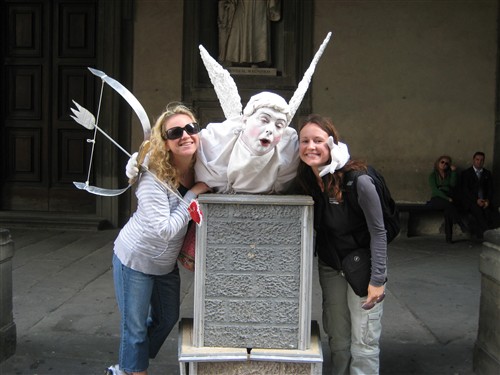 The best thing about Florence however, besides David, is just being in Florence. The neighborhoods are beautiful to walk through with their colorful weathered buildings and pretty café-lined piazzas. A walk along the Arno River that runs through the city affords some of the best views, especially around the Ponte Vecchio – a picturesque bridge with small jewelry shops lining both sides all the way across. But you haven’t seen Florence until you’ve seen it from Piazzale Michelangelo on one of the many hills that surround the city. Only from an elevated position can you take in the sea of red rooftops punctuated by the Duomo and the dreamy Arno, its small bridges reflecting on the lazy river’s glassy surface. We spent over an hour just looking across the cityscape.
The best thing about Florence however, besides David, is just being in Florence. The neighborhoods are beautiful to walk through with their colorful weathered buildings and pretty café-lined piazzas. A walk along the Arno River that runs through the city affords some of the best views, especially around the Ponte Vecchio – a picturesque bridge with small jewelry shops lining both sides all the way across. But you haven’t seen Florence until you’ve seen it from Piazzale Michelangelo on one of the many hills that surround the city. Only from an elevated position can you take in the sea of red rooftops punctuated by the Duomo and the dreamy Arno, its small bridges reflecting on the lazy river’s glassy surface. We spent over an hour just looking across the cityscape.
Florence is a magical city, a Romantic city, a city rightly obsessed with its own colorful, artistic history. Florence is a place to get lost and a place to be found. The spirit of Michelangelo lives on in every piazza, on every street corner, and in the heart of every visitor who beholds the David.
Comments Off on Florence

 Siena flourished in the medieval period, as evidenced by its enduring Gothic architecture and narrow stone streets. Auto traffic has been banished from the town center, making for pleasant pedestrian walkways and a frustrating time for tourists with cars. We managed to find our way into one of the parking garages just inside the medieval city walls and walked uphill into the historic town center – the sloping, bricked Piazza del Campo. Il Campo, as it is also called, is Siena’s social center. The extraordinarily large piazza, surrounded by museums, shops and ubiquitous outdoor cafés, is a pleasant spot for a rest, despite the throngs of tourists (mostly Americans) who pour into it like herds of cattle. Italy is overflowing with tourists and we have encountered more American tourists in Italy than anywhere else in the world.
Siena flourished in the medieval period, as evidenced by its enduring Gothic architecture and narrow stone streets. Auto traffic has been banished from the town center, making for pleasant pedestrian walkways and a frustrating time for tourists with cars. We managed to find our way into one of the parking garages just inside the medieval city walls and walked uphill into the historic town center – the sloping, bricked Piazza del Campo. Il Campo, as it is also called, is Siena’s social center. The extraordinarily large piazza, surrounded by museums, shops and ubiquitous outdoor cafés, is a pleasant spot for a rest, despite the throngs of tourists (mostly Americans) who pour into it like herds of cattle. Italy is overflowing with tourists and we have encountered more American tourists in Italy than anywhere else in the world. The Chianti region, also called Chiantishire, is divided into two sub regions – Chianti Sienese, and Chianti Florentine. Within the region are pretty little stone towns and surrounding the towns are the wineries. As it was already midafternoon, we chose a handful of wineries solely for their geographical location; we knew nothing about any of them. After our frustrating wine tasting experience in Bordeaux, I sent up a silent prayer that the Tuscan winemakers would be a bit more hospitable than the French. The Big Man delivered.
The Chianti region, also called Chiantishire, is divided into two sub regions – Chianti Sienese, and Chianti Florentine. Within the region are pretty little stone towns and surrounding the towns are the wineries. As it was already midafternoon, we chose a handful of wineries solely for their geographical location; we knew nothing about any of them. After our frustrating wine tasting experience in Bordeaux, I sent up a silent prayer that the Tuscan winemakers would be a bit more hospitable than the French. The Big Man delivered.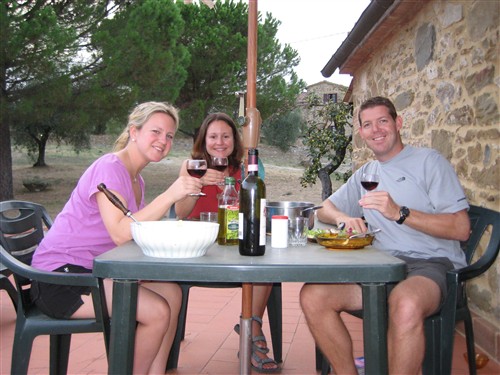 Inside the office, the woman set out three glasses on a desktop, opened a bottle of wine slowly and poured. It is always a bit nerve-racking at the tiny wineries where you’re the only ones there and the family owners conduct a tasting just for you. You know you’ll end up buying a bottle out of obligation and you pray that it’s halfway decent and not too expensive. We each took a sip and smiles spread across our faces. It was fabulous! We happily bought a bottle and then one more of her more expensive vintage which she offered to open for us to taste but we declined, not wanting her to open another for just one taste. It turned out to be the best bottle in our booty from Chianti – and it was a big booty! In a matter of a few hours, we had filled the back seat of our crappy blue Fiat Punto with wine bottles from four different wineries and were on our way back to our wonderful house at Castello di Selvole. It was a damp, chilly night so we cooked another decadent Italian feast and devoured it with our bottle Monteraponi Chianti Classico Riserva “Il Campitello” D.O.C.G. in the warmth of our cozy kitchen.
Inside the office, the woman set out three glasses on a desktop, opened a bottle of wine slowly and poured. It is always a bit nerve-racking at the tiny wineries where you’re the only ones there and the family owners conduct a tasting just for you. You know you’ll end up buying a bottle out of obligation and you pray that it’s halfway decent and not too expensive. We each took a sip and smiles spread across our faces. It was fabulous! We happily bought a bottle and then one more of her more expensive vintage which she offered to open for us to taste but we declined, not wanting her to open another for just one taste. It turned out to be the best bottle in our booty from Chianti – and it was a big booty! In a matter of a few hours, we had filled the back seat of our crappy blue Fiat Punto with wine bottles from four different wineries and were on our way back to our wonderful house at Castello di Selvole. It was a damp, chilly night so we cooked another decadent Italian feast and devoured it with our bottle Monteraponi Chianti Classico Riserva “Il Campitello” D.O.C.G. in the warmth of our cozy kitchen.
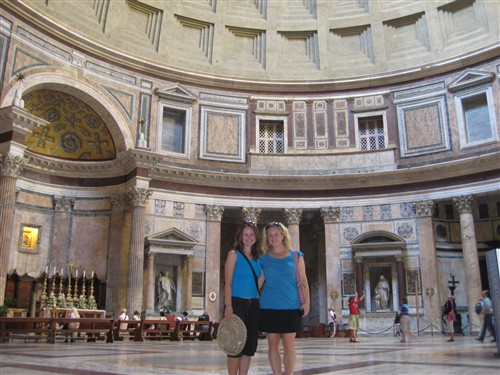 From the outside, it looks nothing like a church and much like a government building. Only after stepping inside do you begin to appreciate its architectural significance. The Pantheon is topped by the largest stone vault ever built – a perfect semisphere, meaning that the diameter (43.4 meters) of the dome is exactly equal to the height. There are no windows. The only natural light enters through a hole at the top of the dome and through the entrance when the tall bronze doors are open. The interior furnishings and embellishment are muted in comparison to other Christian buildings in Rome and elsewhere, with only a few marble sculptures and sparse iconography. Even the altar is decorated simply. The multi-hued stone and the vastness of the dome speak for the Pantheon’s magnificent beauty.
From the outside, it looks nothing like a church and much like a government building. Only after stepping inside do you begin to appreciate its architectural significance. The Pantheon is topped by the largest stone vault ever built – a perfect semisphere, meaning that the diameter (43.4 meters) of the dome is exactly equal to the height. There are no windows. The only natural light enters through a hole at the top of the dome and through the entrance when the tall bronze doors are open. The interior furnishings and embellishment are muted in comparison to other Christian buildings in Rome and elsewhere, with only a few marble sculptures and sparse iconography. Even the altar is decorated simply. The multi-hued stone and the vastness of the dome speak for the Pantheon’s magnificent beauty. Rome is famous for its dreamy piazzas – open squares tucked into the city, often with a central fountain, coming alive on moonlit evenings. The Trevi Fountain – Rome’s most famous – is the focal point of one such piazza. “The baroque bonanza was designed by Nicola Salvi in 1732 and depicts Neptune’s chariot being led by Tritons with sea horses – one wild, one docile – representing the various moods of the sea.” (Lonely Planet, Feb 2008) The piazza was full of people snapping photos, enjoying cones of gelato, or just staring at the Trevi’s mesmerizing dance in its pool of aquamarine.
Rome is famous for its dreamy piazzas – open squares tucked into the city, often with a central fountain, coming alive on moonlit evenings. The Trevi Fountain – Rome’s most famous – is the focal point of one such piazza. “The baroque bonanza was designed by Nicola Salvi in 1732 and depicts Neptune’s chariot being led by Tritons with sea horses – one wild, one docile – representing the various moods of the sea.” (Lonely Planet, Feb 2008) The piazza was full of people snapping photos, enjoying cones of gelato, or just staring at the Trevi’s mesmerizing dance in its pool of aquamarine.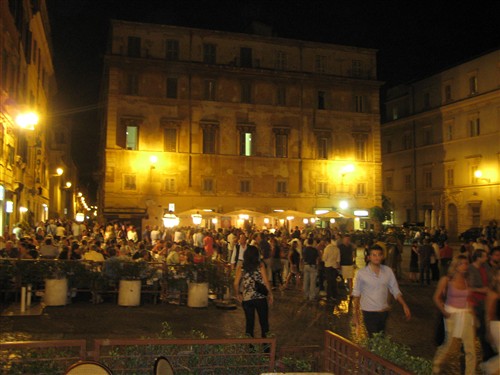
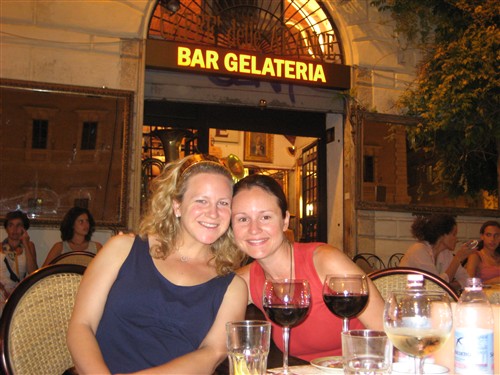 The final stop that I want to mention is the Chiesa di Santa Maria della Concezione – a small, nondescript 17th century church near Piazza Barberini. What makes it one of the most fascinating stops on the tourist trail is the crypt which is decorated with the bones of 4,000 departed monks. We knew going in what we were going to see and still our jaws dropped at the sight of it. The crypt consists of five or six small rooms with dirt floors, each with an elaborate and mesmerizing display. Bones are used to make chandeliers, picture frames, flower patterns and a clock, among many other designs. Some of the skeletons are posed intact, dressed in the brown monks’ robes; some of the faces still have traces of flesh which has yet to decompose. The displays are eerily fascinating. Four thousand monks yield a lot of bones! Stacks of hundreds of femurs, tibias and fibulas line the walls in artistic forms. Hip bones become angel wings under smiling skulls. To see a sense of humor in the designs is both shocking and refreshing. In the last room along the hall, the collective epitaph of the monks is written on a small board: “What you are now we used to be; what we are now you will be.”
The final stop that I want to mention is the Chiesa di Santa Maria della Concezione – a small, nondescript 17th century church near Piazza Barberini. What makes it one of the most fascinating stops on the tourist trail is the crypt which is decorated with the bones of 4,000 departed monks. We knew going in what we were going to see and still our jaws dropped at the sight of it. The crypt consists of five or six small rooms with dirt floors, each with an elaborate and mesmerizing display. Bones are used to make chandeliers, picture frames, flower patterns and a clock, among many other designs. Some of the skeletons are posed intact, dressed in the brown monks’ robes; some of the faces still have traces of flesh which has yet to decompose. The displays are eerily fascinating. Four thousand monks yield a lot of bones! Stacks of hundreds of femurs, tibias and fibulas line the walls in artistic forms. Hip bones become angel wings under smiling skulls. To see a sense of humor in the designs is both shocking and refreshing. In the last room along the hall, the collective epitaph of the monks is written on a small board: “What you are now we used to be; what we are now you will be.”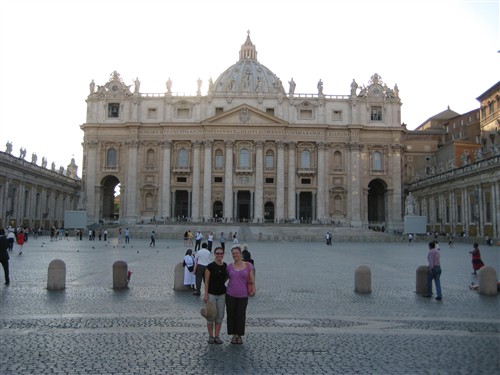
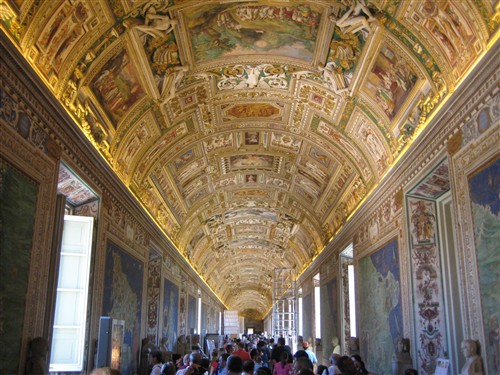 Inside the Pinacoteca, paintings by Raphael, Caravaggio and Da Vinci among others graced the walls. Other galleries contained hundreds of marble busts and statues, enormous tapestries, Etruscan artifacts, and stunning iconography. The Map Gallery was a long hall containing world maps painted in foregone centuries, enlightening the viewer as to the perception of the world long before satellites and Columbus. The private apartments of Pope Julius II were, like the whole of the Vatican Museum, remarkably opulent; every wall, ceiling, and corner of the various salons were richly decorated with religious frescoes, framed paintings, decadent mouldings, and magnificent sculptures. The experience was mindboggling and we hadn’t even made it to the Sistine Chapel yet!
Inside the Pinacoteca, paintings by Raphael, Caravaggio and Da Vinci among others graced the walls. Other galleries contained hundreds of marble busts and statues, enormous tapestries, Etruscan artifacts, and stunning iconography. The Map Gallery was a long hall containing world maps painted in foregone centuries, enlightening the viewer as to the perception of the world long before satellites and Columbus. The private apartments of Pope Julius II were, like the whole of the Vatican Museum, remarkably opulent; every wall, ceiling, and corner of the various salons were richly decorated with religious frescoes, framed paintings, decadent mouldings, and magnificent sculptures. The experience was mindboggling and we hadn’t even made it to the Sistine Chapel yet! No matter what you have previously read or heard or thought, the Sistine Chapel can bring tears to your eyes. Though Michelangelo always considered himself a sculptor and only begrudgingly accepted the papal commission for the ceiling, he poured himself into the work. Declining any assistance, he spent four years (1508-1512) lying on scaffolding, creating what would become one of the world’s most glorious and famous masterpieces.
No matter what you have previously read or heard or thought, the Sistine Chapel can bring tears to your eyes. Though Michelangelo always considered himself a sculptor and only begrudgingly accepted the papal commission for the ceiling, he poured himself into the work. Declining any assistance, he spent four years (1508-1512) lying on scaffolding, creating what would become one of the world’s most glorious and famous masterpieces.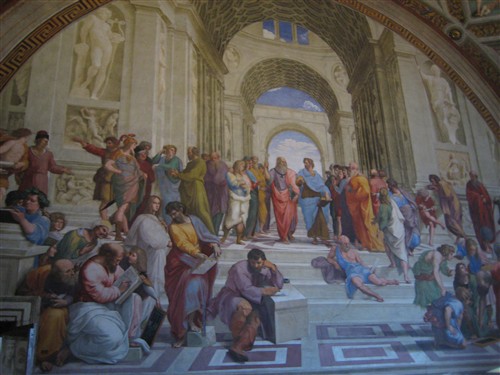 While the security personnel tirelessly hushed the crowd to preserve the sanctity of the atmosphere, the shoulder-to-shoulder crush still detracted from the experience. I wondered if the Pope ever comes in at night, when the doors are locked and he has the place to himself, and lies on his back on the floor, staring up at the ceiling in solitude. I certainly would.
While the security personnel tirelessly hushed the crowd to preserve the sanctity of the atmosphere, the shoulder-to-shoulder crush still detracted from the experience. I wondered if the Pope ever comes in at night, when the doors are locked and he has the place to himself, and lies on his back on the floor, staring up at the ceiling in solitude. I certainly would. The white marble façade of the world’s second largest basilica, decorated with Roman columns and topped with sculptures, is striking but is a vast understatement in comparison to the majestic grandeur of the interior. Among the magnificent marble sculptures on display is Michelangelo’s Pieta. Bathed in soft light, the work exemplifies the artist’s ability to capture movement with the musculature of Christ’s lifeless body and the flowing folds of the Madonna’s robes. Lifelike marble statues by Bernini also decorate the cavernous interior. In the center of the basilica stands the high altar with a magnificent bronze work by Bernini, which stands above St. Peter’s crypt. Above the high altar, Michelangelo’s dome filters daylight through a line of windows below a kaleidoscope of iconography.
The white marble façade of the world’s second largest basilica, decorated with Roman columns and topped with sculptures, is striking but is a vast understatement in comparison to the majestic grandeur of the interior. Among the magnificent marble sculptures on display is Michelangelo’s Pieta. Bathed in soft light, the work exemplifies the artist’s ability to capture movement with the musculature of Christ’s lifeless body and the flowing folds of the Madonna’s robes. Lifelike marble statues by Bernini also decorate the cavernous interior. In the center of the basilica stands the high altar with a magnificent bronze work by Bernini, which stands above St. Peter’s crypt. Above the high altar, Michelangelo’s dome filters daylight through a line of windows below a kaleidoscope of iconography.
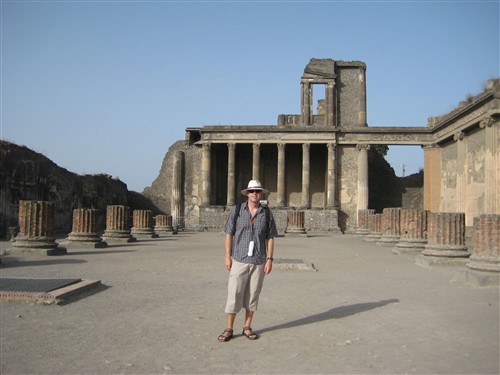 Pompeii, a Roman city that had been in existence for centuries, began to flourish in the 2nd century BC. In AD 79, Mount Vesuvius erupted, covering Pompeii in several meters of toxic volcanic ash. The ancient city remained buried beneath the ash for centuries until traces of it were discovered and excavation began in the 1700s. As fate would have it, the cocoon of ash actually preserved the structures and many of their original frescoes and, after hundreds of years of excavation, most of the remnants have re-emerged.
Pompeii, a Roman city that had been in existence for centuries, began to flourish in the 2nd century BC. In AD 79, Mount Vesuvius erupted, covering Pompeii in several meters of toxic volcanic ash. The ancient city remained buried beneath the ash for centuries until traces of it were discovered and excavation began in the 1700s. As fate would have it, the cocoon of ash actually preserved the structures and many of their original frescoes and, after hundreds of years of excavation, most of the remnants have re-emerged. The most fascinating things that we saw among the Pompeii ruins were the bodies. As the volcanic ash began to fall from the sky, many people suffocated and were buried in the meters of ash. When they died, their bodies became petrified in their final agonizing positions. When the bodies decayed, their petrified shapes remained. They were an eerie sight. There was even one body of a dog that had been chained inside its house, its contorted death pose petrified for eternity.
The most fascinating things that we saw among the Pompeii ruins were the bodies. As the volcanic ash began to fall from the sky, many people suffocated and were buried in the meters of ash. When they died, their bodies became petrified in their final agonizing positions. When the bodies decayed, their petrified shapes remained. They were an eerie sight. There was even one body of a dog that had been chained inside its house, its contorted death pose petrified for eternity.